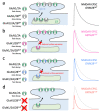Synaptic Dysfunction by Mutations in GRIN2B: Influence of Triheteromeric NMDA Receptors on Gain-of-Function and Loss-of-Function Mutant Classification
- PMID: 35741674
- PMCID: PMC9221112
- DOI: 10.3390/brainsci12060789
Synaptic Dysfunction by Mutations in GRIN2B: Influence of Triheteromeric NMDA Receptors on Gain-of-Function and Loss-of-Function Mutant Classification
Abstract
GRIN2B mutations are rare but often associated with patients having severe neurodevelopmental disorders with varying range of symptoms such as intellectual disability, developmental delay and epilepsy. Patient symptoms likely arise from mutations disturbing the role that the encoded NMDA receptor subunit, GluN2B, plays at neuronal connections in the developing nervous system. In this study, we investigated the cell-autonomous effects of putative gain- (GoF) and loss-of-function (LoF) missense GRIN2B mutations on excitatory synapses onto CA1 pyramidal neurons in organotypic hippocampal slices. In the absence of both native GluN2A and GluN2B subunits, functional incorporation into synaptic NMDA receptors was attenuated for GoF mutants, or almost eliminated for LoF GluN2B mutants. NMDA-receptor-mediated excitatory postsynaptic currents (NMDA-EPSCs) from synaptic GoF GluN1/2B receptors had prolonged decays consistent with their functional classification. Nonetheless, in the presence of native GluN2A, molecular replacement of native GluN2B with GoF and LoF GluN2B mutants all led to similar functional incorporation into synaptic receptors, more rapidly decaying NMDA-EPSCs and greater inhibition by TCN-201, a selective antagonist for GluN2A-containing NMDA receptors. Mechanistic insight was gained from experiments in HEK293T cells, which revealed that GluN2B GoF mutants slowed deactivation in diheteromeric GluN1/2B, but not triheteromeric GluN1/2A/2B receptors. We also show that a disease-associated missense mutation, which severely affects surface expression, causes opposing effects on NMDA-EPSC decay and charge transfer when introduced into GluN2A or GluN2B. Finally, we show that having a single null Grin2b allele has only a modest effect on NMDA-EPSC decay kinetics. Our results demonstrate that functional incorporation of GoF and LoF GluN2B mutants into synaptic receptors and the effects on EPSC decay times are highly dependent on the presence of triheteromeric GluN1/2A/2B NMDA receptors, thereby influencing the functional classification of NMDA receptor variants as GoF or LoF mutations. These findings highlight the complexity of interpreting effects of disease-causing NMDA receptor missense mutations in the context of neuronal function.
Keywords: central nervous system; de novo mutations; electrophysiology; ionotropic glutamate receptors; synaptic transmission.
Conflict of interest statement
The authors declare no conflict of interest. The funders had no role in the design of the study; in the collection, analyses, or interpretation of data; in the writing of the manuscript, or in the decision to publish the results.
Figures







Similar articles
-
GRIN2B-related neurodevelopmental disorder: current understanding of pathophysiological mechanisms.Front Synaptic Neurosci. 2023 Jan 10;14:1090865. doi: 10.3389/fnsyn.2022.1090865. eCollection 2022. Front Synaptic Neurosci. 2023. PMID: 36704660 Free PMC article. Review.
-
Effects of GluN2A and GluN2B gain-of-function epilepsy mutations on synaptic currents mediated by diheteromeric and triheteromeric NMDA receptors.Neurobiol Dis. 2020 Jul;140:104850. doi: 10.1016/j.nbd.2020.104850. Epub 2020 Apr 1. Neurobiol Dis. 2020. PMID: 32247039
-
Opportunities for Precision Treatment of GRIN2A and GRIN2B Gain-of-Function Variants in Triheteromeric N-Methyl-D-Aspartate Receptors.J Pharmacol Exp Ther. 2022 Apr;381(1):54-66. doi: 10.1124/jpet.121.001000. Epub 2022 Feb 2. J Pharmacol Exp Ther. 2022. PMID: 35110392 Free PMC article.
-
Functional and pharmacological properties of triheteromeric GluN1/2B/2D NMDA receptors.J Physiol. 2019 Nov;597(22):5495-5514. doi: 10.1113/JP278168. Epub 2019 Nov 2. J Physiol. 2019. PMID: 31541561 Free PMC article.
-
The differences between GluN2A and GluN2B signaling in the brain.J Neurosci Res. 2018 Aug;96(8):1430-1443. doi: 10.1002/jnr.24251. Epub 2018 Apr 22. J Neurosci Res. 2018. PMID: 29682799 Review.
Cited by
-
GRIN2B-related neurodevelopmental disorder: current understanding of pathophysiological mechanisms.Front Synaptic Neurosci. 2023 Jan 10;14:1090865. doi: 10.3389/fnsyn.2022.1090865. eCollection 2022. Front Synaptic Neurosci. 2023. PMID: 36704660 Free PMC article. Review.
-
Rescuing tri-heteromeric NMDA receptor function: the potential of pregnenolone-sulfate in loss-of-function GRIN2B variants.Cell Mol Life Sci. 2024 May 25;81(1):235. doi: 10.1007/s00018-024-05243-x. Cell Mol Life Sci. 2024. PMID: 38795169 Free PMC article.
-
Circadian rhythm disruptions associated with opioid use disorder in synaptic proteomes of human dorsolateral prefrontal cortex and nucleus accumbens.Mol Psychiatry. 2023 Nov;28(11):4777-4792. doi: 10.1038/s41380-023-02241-6. Epub 2023 Sep 6. Mol Psychiatry. 2023. PMID: 37674018 Free PMC article.
-
Disease-Associated Variants in GRIN1, GRIN2A and GRIN2B genes: Insights into NMDA Receptor Structure, Function, and Pathophysiology.Physiol Res. 2024 May 31;73(Suppl 1):S413-S434. doi: 10.33549/physiolres.935346. Epub 2024 May 31. Physiol Res. 2024. PMID: 38836461 Free PMC article. Review.
-
Selective Cell-Surface Expression of Triheteromeric NMDA Receptors.Methods Mol Biol. 2024;2799:55-77. doi: 10.1007/978-1-0716-3830-9_5. Methods Mol Biol. 2024. PMID: 38727903 Free PMC article.
References
-
- Hansen K.B., Wollmuth L.P., Bowie D., Furukawa H., Menniti F.S., Sobolevsky A.I., Swanson G.T., Swanger S.A., Greger I.H., Nakagawa T., et al. Structure, Function, and Pharmacology of Glutamate Receptor Ion Channels. Pharmacol. Rev. 2021;73:298–487. doi: 10.1124/pharmrev.120.000131. - DOI - PMC - PubMed
-
- Kew J.N., Koester A., Moreau J.L., Jenck F., Ouagazzal A.M., Mutel V., Richards J.G., Trube G., Fischer G., Montkowski A., et al. Functional Consequences of Reduction in NMDA Receptor Glycine Affinity in Mice Carrying Targeted Point Mutations in the Glycine Binding Site. J. Neurosci. 2000;20:4037–4049. doi: 10.1523/JNEUROSCI.20-11-04037.2000. - DOI - PMC - PubMed
Grants and funding
LinkOut - more resources
Full Text Sources
Miscellaneous

